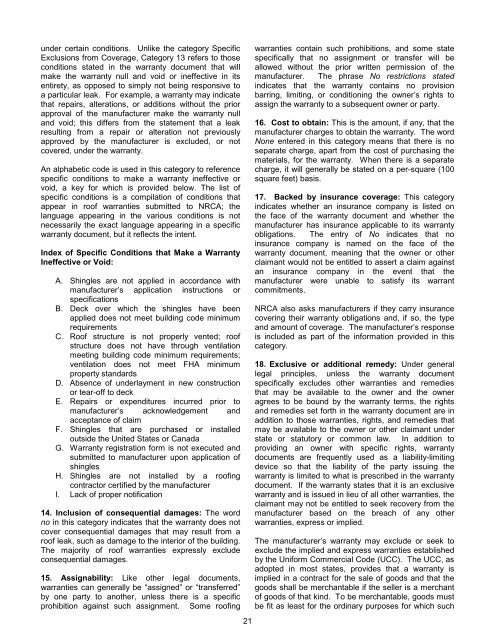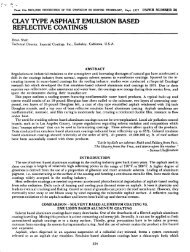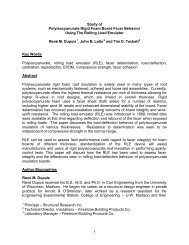2000 by the National Roofing Contractors Association. No
2000 by the National Roofing Contractors Association. No
2000 by the National Roofing Contractors Association. No
Create successful ePaper yourself
Turn your PDF publications into a flip-book with our unique Google optimized e-Paper software.
under certain conditions. Unlike <strong>the</strong> category Specific<br />
Exclusions from Coverage, Category 13 refers to those<br />
conditions stated in <strong>the</strong> warranty document that will<br />
make <strong>the</strong> warranty null and void or ineffective in its<br />
entirety, as opposed to simply not being responsive to<br />
a particular leak. For example, a warranty may indicate<br />
that repairs, alterations, or additions without <strong>the</strong> prior<br />
approval of <strong>the</strong> manufacturer make <strong>the</strong> warranty null<br />
and void; this differs from <strong>the</strong> statement that a leak<br />
resulting from a repair or alteration not previously<br />
approved <strong>by</strong> <strong>the</strong> manufacturer is excluded, or not<br />
covered, under <strong>the</strong> warranty.<br />
An alphabetic code is used in this category to reference<br />
specific conditions to make a warranty ineffective or<br />
void, a key for which is provided below. The list of<br />
specific conditions is a compilation of conditions that<br />
appear in roof warranties submitted to NRCA; <strong>the</strong><br />
language appearing in <strong>the</strong> various conditions is not<br />
necessarily <strong>the</strong> exact language appearing in a specific<br />
warranty document, but it reflects <strong>the</strong> intent.<br />
Index of Specific Conditions that Make a Warranty<br />
Ineffective or Void:<br />
A. Shingles are not applied in accordance with<br />
manufacturer’s application instructions or<br />
specifications<br />
B. Deck over which <strong>the</strong> shingles have been<br />
applied does not meet building code minimum<br />
requirements<br />
C. Roof structure is not properly vented; roof<br />
structure does not have through ventilation<br />
meeting building code minimum requirements;<br />
ventilation does not meet FHA minimum<br />
property standards<br />
D. Absence of underlayment in new construction<br />
or tear-off to deck<br />
E. Repairs or expenditures incurred prior to<br />
manufacturer’s acknowledgement and<br />
acceptance of claim<br />
F. Shingles that are purchased or installed<br />
outside <strong>the</strong> United States or Canada<br />
G. Warranty registration form is not executed and<br />
submitted to manufacturer upon application of<br />
shingles<br />
H. Shingles are not installed <strong>by</strong> a roofing<br />
contractor certified <strong>by</strong> <strong>the</strong> manufacturer<br />
I. Lack of proper notification<br />
14. Inclusion of consequential damages: The word<br />
no in this category indicates that <strong>the</strong> warranty does not<br />
cover consequential damages that may result from a<br />
roof leak, such as damage to <strong>the</strong> interior of <strong>the</strong> building.<br />
The majority of roof warranties expressly exclude<br />
consequential damages.<br />
15. Assignability: Like o<strong>the</strong>r legal documents,<br />
warranties can generally be “assigned” or “transferred”<br />
<strong>by</strong> one party to ano<strong>the</strong>r, unless <strong>the</strong>re is a specific<br />
prohibition against such assignment. Some roofing<br />
21<br />
warranties contain such prohibitions, and some state<br />
specifically that no assignment or transfer will be<br />
allowed without <strong>the</strong> prior written permission of <strong>the</strong><br />
manufacturer. The phrase <strong>No</strong> restrictions stated<br />
indicates that <strong>the</strong> warranty contains no provision<br />
barring, limiting, or conditioning <strong>the</strong> owner’s rights to<br />
assign <strong>the</strong> warranty to a subsequent owner or party.<br />
16. Cost to obtain: This is <strong>the</strong> amount, if any, that <strong>the</strong><br />
manufacturer charges to obtain <strong>the</strong> warranty. The word<br />
<strong>No</strong>ne entered in this category means that <strong>the</strong>re is no<br />
separate charge, apart from <strong>the</strong> cost of purchasing <strong>the</strong><br />
materials, for <strong>the</strong> warranty. When <strong>the</strong>re is a separate<br />
charge, it will generally be stated on a per-square (100<br />
square feet) basis.<br />
17. Backed <strong>by</strong> insurance coverage: This category<br />
indicates whe<strong>the</strong>r an insurance company is listed on<br />
<strong>the</strong> face of <strong>the</strong> warranty document and whe<strong>the</strong>r <strong>the</strong><br />
manufacturer has insurance applicable to its warranty<br />
obligations. The entry of <strong>No</strong> indicates that no<br />
insurance company is named on <strong>the</strong> face of <strong>the</strong><br />
warranty document, meaning that <strong>the</strong> owner or o<strong>the</strong>r<br />
claimant would not be entitled to assert a claim against<br />
an insurance company in <strong>the</strong> event that <strong>the</strong><br />
manufacturer were unable to satisfy its warrant<br />
commitments.<br />
NRCA also asks manufacturers if <strong>the</strong>y carry insurance<br />
covering <strong>the</strong>ir warranty obligations and, if so, <strong>the</strong> type<br />
and amount of coverage. The manufacturer’s response<br />
is included as part of <strong>the</strong> information provided in this<br />
category.<br />
18. Exclusive or additional remedy: Under general<br />
legal principles, unless <strong>the</strong> warranty document<br />
specifically excludes o<strong>the</strong>r warranties and remedies<br />
that may be available to <strong>the</strong> owner and <strong>the</strong> owner<br />
agrees to be bound <strong>by</strong> <strong>the</strong> warranty terms, <strong>the</strong> rights<br />
and remedies set forth in <strong>the</strong> warranty document are in<br />
addition to those warranties, rights, and remedies that<br />
may be available to <strong>the</strong> owner or o<strong>the</strong>r claimant under<br />
state or statutory or common law. In addition to<br />
providing an owner with specific rights, warranty<br />
documents are frequently used as a liability-limiting<br />
device so that <strong>the</strong> liability of <strong>the</strong> party issuing <strong>the</strong><br />
warranty is limited to what is prescribed in <strong>the</strong> warranty<br />
document. If <strong>the</strong> warranty states that it is an exclusive<br />
warranty and is issued in lieu of all o<strong>the</strong>r warranties, <strong>the</strong><br />
claimant may not be entitled to seek recovery from <strong>the</strong><br />
manufacturer based on <strong>the</strong> breach of any o<strong>the</strong>r<br />
warranties, express or implied.<br />
The manufacturer’s warranty may exclude or seek to<br />
exclude <strong>the</strong> implied and express warranties established<br />
<strong>by</strong> <strong>the</strong> Uniform Commercial Code (UCC). The UCC, as<br />
adopted in most states, provides that a warranty is<br />
implied in a contract for <strong>the</strong> sale of goods and that <strong>the</strong><br />
goods shall be merchantable if <strong>the</strong> seller is a merchant<br />
of goods of that kind. To be merchantable, goods must<br />
be fit as least for <strong>the</strong> ordinary purposes for which such





